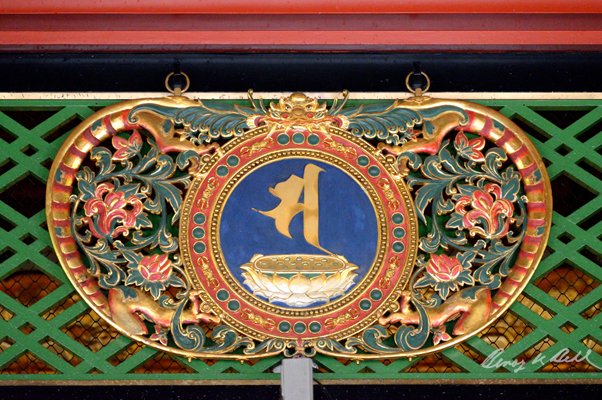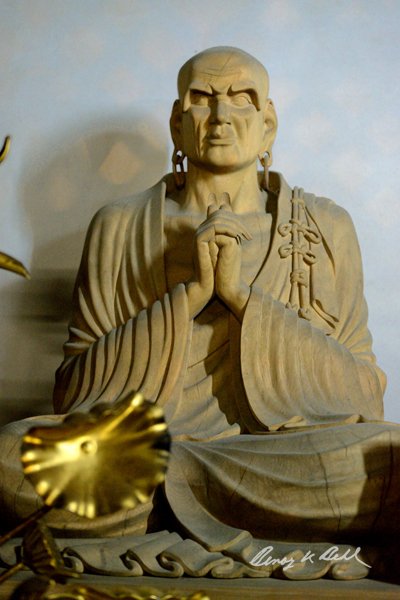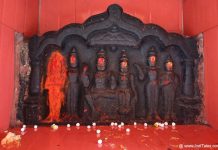Most people are not aware that at least a score of Hindu deities is very actively worshiped in Japan. In fact, there are hundreds of shrines to Saraswati alone. There are innumerable representations of Lakshmi, Indra, Brahma, Ganesha, Garuda, and other deities. In fact, deities we have practically forgotten in India, such as Vayu and Varuna are still worshiped in Japan.

Hindu Deities & Indian Culture in Japan

In many ways, I find that Japan has preserved ancient Indian traditions, even when they may have changed here in India. For instance, in Japan, Saraswati is depicted and venerated not only with the Veena but also remembered for her association with water. (One may recall that Saraswati is originally the personification of the river by that name.) Therefore, she is also worshiped in pools of water in Japan.

Sanskrit

The 6th-century Siddham script is preserved in Japan, though we do not use it in India. ‘Beejaksharas’ of Sanskrit in this script are regarded as holy and are given great importance. Each deity has a ‘Beejakshara’ and these are venerated by the people, even though most of them cannot read it.
If you go to Japanese tombs, you find the Sanskrit alphabet. The Japanese cannot read this alphabet, but it is still used to respect the dead. It is very interesting that the 5th-century Siddham script, which has disappeared in India, is still in use in Japan. At Koyasan, they still have a school where Sanskrit is taught with Siddham.
Homa – Hindu Deities and Indian Culture in Japan

Many links in the development of Vajrayana Buddhism can be found in a study of Japanese Buddhism. Today’s Himalayan Buddhism is a later development and has lost the typical ‘havan’ or ‘Homa’. I was delighted to find and record the continuance of the tradition of ‘Homa’ in some of the most important Japanese Buddhist sects, who call it ‘goma’. Sanskrit sutras are also chanted on the occasion and it is much like the ‘havan’ which we are all familiar with.
Language

Very many words in the Japanese language are from Sanskrit. Sanskrit was also the basis for the formation of the Japanese alphabet ‘Kana’.
In the supermarkets, a major brand of milk products is called ‘Sujata’. The company personnel is taught the story of Sujata who gave sweet rice milk to the Buddha, with which he broke his period of austerity before he gained Enlightenment.
Philosophy

There are deep meanings in Japanese practices which take us back to the early developments of philosophy in India. In many ways, philosophic understanding is most well preserved in Japan. Japan has not had the breakdown of cultural norms which India suffered when a colonial education system was created. Therefore, most Indians learned about our own culture from the Western point of view. The dominant and admired language was English, which remains today. Obviously, all our books and education in schools and universities are rooted in the English vision.
Japan and India

Our relationship with Japan is far closer than Indians seem to be aware of. It is time to understand this and build upon it. It is time, in fact, for the world to learn from the peaceful and civilized outlook which is rooted in ancient India and in the culture of countries like Japan. And it is about time to stop destroying ourselves and the world around us, through unthinking and uncaring commercialism.
People of the “modern” outlook need not be concerned that looking to ancient culture will lead to less economic development. In fact, culture provides discipline, meaning, and concentration in life, which makes us truly successful in all that we do. What is more, it also leads to good health and happiness.
Japan is the one country where Buddhism is flourishing in all its facets. Here, technology and transcendence are living together. The deep-rooted spirit of Buddha’s teachings energies the Japanese people.
Buddhist temples are numerous and vast numbers of people visit them every day. Besides the Buddha, so many ancient Indian deities and practices are preserved in these temples. An Indian feels quite at home in Japan.

Bodhisena Statue, Ryosenji, Nara. In the eighth century, the Indian priest Bodhisena was invited by the Japanese Emperor to Japan. He conducted the eye-opening ceremony of the Great Buddha of the Todaiji temple in 752. Bodhisena is believed to have been in South India.
Saraswati or Benzaiten Shrine, Bentenshu, Osaka. This must be the most impressive and tallest shrine to Saraswati anywhere in the world today.
About Benoy K Behl
Benoy K Behl is a filmmaker, art historian, and photographer who is known for his tireless and prolific output of work over the past 36 years. Behl’s photographic exhibitions have been warmly received in 54 countries around the world. He holds the Limca Book Record for being the most traveled photographer.
Behl’s films, including 26 documentaries on ‘The Paintings of India’, 26 documentaries on ‘The Sculpture of India’, and 26 documentaries on ‘Spectacular India’ have been nationally telecast on prime time in India. Behl’s film on ‘Indian Roots of Tibetan Buddhism’, with interviews with HH Dalai Lama, won the Best Documentary Producer Award at the Madrid International Film Festival 2015.
PS: This is a guest post on ‘Hindu Deities and Indian Culture in Japan’ by Benoy K Behl for IndiTales. His book ‘The Ajanta Caves’ remains my personal favorite to understand the stories hidden in the paintings of Ajanta. It is an honor to have him on this blog. Thank you, Benoy.














this is indeed news 2 me anuji.
i thot shintoism and budhism r the only popular religions in japan.
your findings i wud say may b communicated 2 the indo-japan fora, the envoys`s offices.
bcos the talks there r only on business, toyota, cars, quality, honda, and the likes.
Brilliant post. Did not know about the deep connection between ancient India and Japan.
Thanks Vinayak. It was a revelation for me too, that is why I requested Benoy to do this post for IndiTales.
There are so many matching in Indian culture and in Japanese culture . Great post with amazing facts
Yes, I was surprised to know about these similarities when Benoy told me first. Happy that you liked the post.
Great job
Need to rewrite our history and teach in a schools.
Thankyou for sharing.
True Jignesh, this is a part of the history that we all need to know.
बहुत सुंदर ब्लॉग. सुना तो था पर फोटो के साथ पढने में बहुत आनंद आया. शेयर करने के लिए धन्यवाद.
हर्ष जी, आपको पढ़ कर अच्छा लगा, ये सुनकर हमें बहुत अच्छा लगा. हमारे साथ बने रहिए और अपने विचार सांझा करते रहिए.
Happy to see Sanskrit in Japan, however in its old form. Now, can it be presumed that Japanese letters are metamorphosis of Sanskrit letters?
Sir, I can not say it with any authority, but it seems like a logical conclusion that Japanese script is derived from old Sanskrit script. If you watch the video in the post – Japanese priests say that base of Japanese culture is Indian culture.
Hello, I am a young Indian woman residing in the US. I have been trying since my school days to study japanese and visit or study in japan but no success. I know basic Japanese. I am very much interested in studying authentic traditional Japanese culture. I want to find out what is the scope of potentially sharing my authentic, traditional indian culture there? I am a professional who actively and formally studies culture. Thanks.
Rashmi – you will have to get in touch with some Indians who live in Japan. This is just a travelogue.
Wonderful Anuradha Ji ! This is amazing and brilliant; I feel further educated on a topic of great interest to me and all thanks to your blog. This will also help many Indians and more westerners to view Japan- India synergies in the right perspective. Please continue the good work.
Thank you, Amitabh Ji. I am yet to visit Japan, this is a guest post by Benoy Behl. However, I do hope to visit these temples sometime in life.
Anuradha,
Japan is beautiful and I seriously admire how passionately you write and how well you capture the environment of whichever place you write about. I also really enjoy the way you capture Indian culture within an entirely different country. I myself notice melting pots of culture in something as simple as my backyard and after reading this post, my eyes have opened even more to the plethora of culture around me.